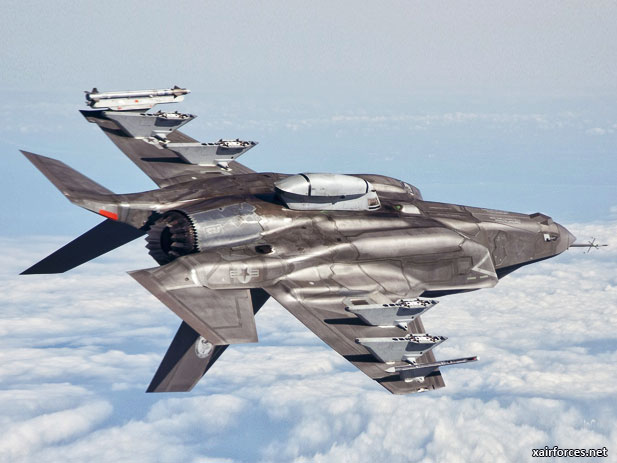
U.S. Air Force approves start of F-35 pilot training

* Six groups of six instructors to be trained on A-model
* Training includes classroom, simulator and flights
* Overlap with development poses training challenges-General
The U.S. Air Force on Monday approved the formal start of pilot training on the A-model of the F-35 Joint Strike Fighter at a Florida military base, paving the way for 36 expert pilots to be trained next year as instructors for the new stealth warplane.
Air Force General Edward Rice, the four-star general in charge of Air Education and Training Command, said an operational evaluation completed this fall showed that Eglin Air Force Base was ready to start training pilots to fly the radar-evading Lockheed Martin Corp F-35 jet in January.
"It's a milestone," Rice told Reuters in a telephone interview. "We are ready at this point to begin our formal training program."
The news came days after the Pentagon signed a $3.8 billion contract with Lockheed to buy a fifth batch of F-35s, a move that safeguarded those funds from automatic budget cuts that are due to start taking effect in January, unless Congress finds other ways to cut the deficit.
Rice announced his decision to declare the F-35 "ready for training" after a meeting with officers who oversee the Florida air base, where the Marine Corps is also training its pilots to fly the B-model of the new plane. Air Force Lieutenant General Christopher Bogdan, the Pentagon's F-35 program manager, was also slated to visit the Florida base on Monday.
Colonel Andrew Toth, commander of the 33rd Fighter Wing at the base, said a total of 88 pilots were slated for F-35 training next year, including pilots from the Marines Corps, Navy and foreign militaries, in addition to the Air Force.
"The pace of operations will not slow as we continue to grow and we are ready for the new challenges next year will bring," he told a teleconference.
Rice said training pilots to fly the F-35 posed some unique challenges because it is the Air Force's most complex weapons system and there is a large degree of concurrency, or overlap, between development and production on the program.
"We are going to see upgrades of the aircraft more frequently than we would in a more mature system. That will introduce a level of complexity that we don't normally (have)," Rice said.
Over coming years, he said, training will have to keep pace with hardware and software upgrades to the "very basic version of the aircraft" that was on the flight line now at the base.
He said Monday's decision cleared the way for six groups of six pilots to be trained to fly the Air Force's conventional takeoff and landing model of the F-35, a single-seat, single-engine warplane, over the course of the coming year.
Lockheed is building three models of the plane for the U.S. military and eight countries that are helping to fund its development: Britain, Italy, Turkey, Norway, Denmark, Australia, the Netherlands and Canada.
Toth said a Dutch pilot would be trained starting next month, with UK pilots to follow later in the year.
Lockheed welcomed the decision and said it looked forward to supporting increased pilot and mechanic training on the F-35.
"Today's declaration of "Ready for Training" begins a new chapter for the service and our international partners," said Lockheed spokeswoman Laura Siebert.
RIGOROUS TRAINING
For now, only experienced pilots who have been instructors for other aircraft will be trained to fly the F-35 A-model, Toth said. The first group of brand new pilots were slated to start training in 2015 at Luke Air Force Base in Arizona, he said.
Eventually Eglin expects to train 100 pilots a year to fly the jets, and some 2,100 mechanics to service the planes.
Toth said the Air Force expected to complete operational testing of the jets and declare them ready for military use around 2016.
Starting Jan. 7, the Air Force said new F-35A pilots will spend about six weeks in a classroom learning about the new plane, and six weeks of flying time.
They will receive about 130 hours of instruction, including 21 hours on a simulator that prepares them for in-flight emergencies such as an engine fire and to use a new helmet that fuses data from the many sensors on the plane.
Toth said the current version of the helmet, which has faced some technical challenges, was working well, but pilots could only fly during the daytime and had to avoid thunderstorms.
Each pilot will also spend nearly 23 hours training on a ground-based device that prepares them to use the plane's ejection seat.
Rice, who flew B-52 and B-2 bombers, said the sophistication of the sensors and other systems on board the F-35 meant that the plane's pilots needed different skills than the pilots who trained for aerial dogfights during World War Two.
Today's F-35 pilots will distinguish themselves more by being able to maximize the capabilities of the high-end electronics systems than by their prowess in maneuvers.
More than 500 mechanics have already been trained at the air base to maintain the new fighter jet, which has special coatings to make it nearly invisible to enemy radar.
Eleven experienced fighter pilots have learned to fly the A-model of the F-35 since the Air Force approved initial military flights last February.
Rice said a new, automated on-board logistics system would eventually make it easier for mechanics to troubleshoot problems with the new planes, but the software system was still at an early stage and required more work - as did the overall software needed to fly the plane.
Source: WASHINGTON (Reuters)- 17 December 2012
Photo: The U.S. Air Force F-35A (Photo by Youngester)
(17.12.2012)
|